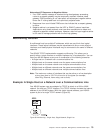
Dead Gateway Processing
RFC-1122,
Requirements For Internet Hosts - Communication Layers
, requires the
IP layer to include a dead gateway algorithm to manage suspected gateway
failures. This section is intended to give you an overview of dead gateway
processing.
Two types of gateway failures can occur:
v Failure of a first-hop gateway. A first-hop gateway is the gateway that is specified
in an IP route. First-hop gateways must be on a directly-connected network. This
type of failure can be detected by either TCP or the data link layer.
v Failure of a gateway other than the first-hop gateway. The path between source
and destination TCP/IP hosts can traverse multiple gateways. This type of failure
can be detected only by TCP.
Dead gateway processing is initiated when IP receives a negative advice indicator
from either TCP or the data link layer. These indicators from TCP and the data link
layer are referred to as advice since they may result from transient conditions as
well as from a serious gateway failure.
Negative Advice from TCP or the Data Link Layer
Retransmissions on a TCP connection occur as a result of transient or non-transient
problems somewhere along the path to a destination host. When TCP notices
excessive retransmissions on a TCP connection, a TCP negative advice indicator is
sent to IP.
The data link layer passes a negative advice indicator to IP when it is unable to
transmit data to a first-hop (directly-connected) gateway. In most cases, negative
advice from the data link layer means that the Address Resolution Process (ARP)
processing performed by the data link layer was unable to resolve the location of
first-hop gateway on the directly connected physical network. (ARP is not performed
on all physical network types. Some physical network types, such as X.25, use an
alternative scheme for this purpose.)
Negative advice, whether from TCP or the data link layer, is always expressed in
terms of the first-hop gateway. Dead gateway processing on a given host only
attempts to verify the first-hop gateway. However, gateways also carry out their own
dead gateway processing for other adjacent gateways. In this way, all of the
gateways along the path to a destination host are taken care of.
How IP Responds to Negative Advice
When receiving negative advice from TCP or the data link layer concerning a next
hop gateway, IP marks all routes that use this gateway as suspect. IP attempts to
deliver data destined for the suspect gateway via routes that use other gateways (if
any are configured). Next, an IP process is started that uses periodic PING
requests to attempt to contact the suspect next-hop gateway. If the suspect
gateway continues to be unresponsive for an extended period of time, the
frequency of the PING requests is reduced.
When any PING response is received from a suspect gateway, the gateway is
considered active and the routes are restored.
78 OS/400 TCP/IP Configuration and Reference V4R4


















